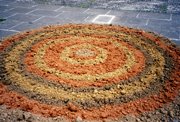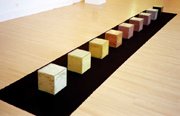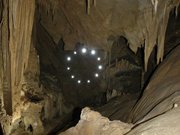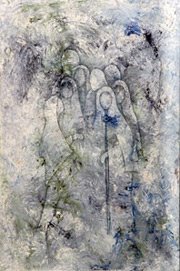Speleoarte jardunaldiak
2007-05-18 / 2007-06-1
Aurkezpena
Erakusketa hau kobak eta espeleologiarekin erabat loturiko 6 artisten lanetan oinarritzen da: Edu Gordo, Roberto Garay eta Santi Urrutia, Gernikako ADES espeleologia taldeko partaideak, eta Ian Ellis Chandler artista ingelesa, Stacy Koffman estatubatuarra, eta Tommy Barr ipar irlandarra. Lanik gehienak Gernikan burutu dira 2007ko maiatzaren hirugarren astean, urteurren bi elkartzen izan direla oinarritzat hartuta: ADES espeleologia taldearen fundazioaren 25. urteurrena eta Gernikako bonbardaketaren 70. urtea. Guzti hau kontuan hartuta artistek kobarekin lotutako kontzeptu honekin lan egin dute: Aterpea.
Presentación
Esta exposición se basa en los trabajos de seis artistas estrechamente relacionados con el mundo de las cuevas y la espeleología: Edu Gordo, Roberto Garay y Santi Urrutia, vinculados al grupo de espeleología ADES de Gernika, y el artista inglés Ian Ellis Chandler, la estadounidense Stacy Koffman, y el norirlandés Tommy Barr. La mayoría de los trabajos se han realizado en Gernika durante la tercera semana de mayo del 2007, a raíz de la celebración de dos aniversarios: el 25 aniversario de la fundación del Grupo de Espeleología ADES, y el 70 aniversario del bombardeo de Gernika. Con este motivo los artistas trabajaron con un concepto relacionado con la cueva: Refugio.
Presentation
This art exhibition is based in works made by six artists related to caves and caving: Edu Gordo, Roberto Garay and Santi Urrutia, linked with the caving group ADES of Gernika, and the English artist Ian Ellis Chandler, Stacy Koffman of United States, and Tommy Barr of North Ireland. Most of works were made in Gernika in the third week of May 2007, on the occasion of two anniversaries: the 25 years of ADES caving group foundation, and the 70 anniversary of the bombing of Gernika. The leitmotif for the artists work was this concept related with caves: Shelter.
ERAKUSKETA
...................................
maiatzaren 18an zabaldu zan eta ekainaren 1ean itxi
Lekua: Gernikako Kultur Etxea.

BARRUA Kobazuloak aspalditik nire arte-lanaren elementu aktiboak dira. Egiten ditudan okupazioak, lurpeko espazio horietan eta hantxe bizi ditudan esperientzietan oinarritzen dira beti. Batzutan, lana kobazuloa eta ikusleen artean sortzen den harremanaren emaitza da, Argia deritzon lanean, adibidez. Aspaldion , 2005etik honantz, hain zuzen, naturan eginiko interbenzioen proiektua garatzen nago, Aztarna proiektua. Leku ezberdinetako lurrak trukatzen ditut. Aurreko leku batetik hartu dudan lurrarekin forma sinplea marrazten dut zoruan eta handik ateratzen dudan lurra hurrengo aztarna egiteko erabiltzen dut mugagabeko sekuentzia bat eginez.Bizitzaren metafora da, norberaren barruko hazieraren metafora. Hartu-emona.
Jardunaldi honetan egingo dudan okupazioan kobazuloa aterpetzat hartzen dut. Barrua lurraren barruan babestuko dut.
Even though I am perceived as an artist who creates work which can cut sharply into Irelands past, I seldom feel entitled to paint images which comment on the history and struggles of other nations. I feel it is the right and responsibility of each nation to handle their legacy in a way which provides dignity and a positive future for all.
For this 70th anniversary exhibition, I wish to create work which draws upon the shared primitive within us all. To create images which reinforces our sameness, by referencing the primitive art of both Spain and Ireland.
Deep within each of us is the need for shelter. Only having found this are we free to strive for comfort. After this comes the desire to create beauty. This progression is consistent across time. From the painted caves of northern Spain to the stately homes of the modern capital city, shelter and comfort can be seen to support the creation of beauty.
For this exhibition I have sought to draw upon our primitive heritage to produce images of beauty. In this context, I consider these to be a celebration of the shelter and comfort which we are fortunate to enjoy. Shelter and comfort which we all too often take for granted.

STACY KOFFMAN
Shelters of the Mind
As I began my endeavor to create works for this exhibition, I immediately searched through sketchbooks from my trip to Madrid and Cantabria in 2005. In Madrid, I spent several hours viewing the sketches and final painting of Gernika by Picasso. This experience moved me beyond words. In Northern Spain, I visited several caves in search of prehistoric art. This too, left a very strong impact on my life that I will never forget. The primitive qualities of these works relate directly to my own imagery and the intuitive processes I use to create.
I continued to think about the connections between these experiences in Spain and how I might create new imagery from it. The cross-section of the karsts and the landscape format quickly came to the forefront. My original inspiration came from two particular images of the Grotta Gigante in Italy and the Sotano de las Golondrinas from Mexico. For me, these images resemble continents, maps, and passages, a metaphor for my recent and future travels abroad. The idea of “shelter” in combination with the karsts led me to create a direct visual connection with the addition of houses at the entrance into the caves. The ladder imagery was the last point of the process, scratching through the surface to build connections within the space presented.
As I continue my research and travels, I always return home to “my shelter”. But I also feel we all carry a shelter within us that allows us the freedom to explore and cultivate stronger understandings of all cultures and peoples. We have to remain open to change and hope and the belief that we as human beings are capable of deeper connections and understandings of each other. It is my hope that these images provide the viewer a moment of contemplation to delve deeper into their own “shelters of the mind” and find the ability to explore beyond it.

ROBERTO GARAY
El refugio eterno
Siempre estuve a gusto en los mundos angostos y oscuros. Nací varios días más tarde de cuando mi madre salía de cuentas, y mis maravillosos recuerdos de mi estancia en aquella cálida cueva aún permanecen grabados a fuego en mi subconsciente. En todo éste tiempo he intentado con poca fortuna volver a explorar espacios similares, pero la mayoría de las chicas me han dificultado la exploración.
En mis primeras e inexpertas incursiones adolescentes o no encontraba la boca o imaginaba que la galería acababa a los pocos metros. Si yo estaba en plena forma, me fallaba el equipo; si no era yo el que fallaba. Otras veces, era la cueva la que bajaba con crecida, impidiendo toda progresión.
Pues eso. No tuve otra elección que dedicarme a la espeleología.
 SANTI URRUTIA
SANTI URRUTIA Aterperik ez
Bonbardaketa negargarria,
ba ote da inon aterperik?
Jendea Atxagako koban ezkutatu zen,
hantxe aurkitu zuen gordelekua,
bonbardaketan.
Gu ere hara joan gara,
babes bila,
baina,
non dago koba?
non gordelekua?
Ez dago ezer,
dena desagertu da,
dena hondatu.
Ez da babesik,
ez aterperik,
ez gordetzeko lekurik.
Sin refugio
Un terrible bombardeo.
Habrá algún refugio?
La gente se ocultó en la cueva de Atxaga,
encontró allí un escondite,
durante el bombardeo.
Nosotros también hemos ido allí,
buscando protección,
pero,
dónde está la cueva?
dónde el escondite?
No hay nada,
todo ha desaparecido,
todo está destruido.
No hay protección,
ni refugio,
ni dónde esconderse.
No shelter
Terrible bombing.
Is there shelter somewhere?
People were hiding in the cave of Atxaga
There they found a shield
From the bombing.
We went there as well,
Looking for shelter,
But,
Where is the cave?
Where is the refuge?
There is nothing.
Everything has disappeared.
All is destroyed.
There is no protection,
No shelter,
No where to hide.

The shed (El cobertizo de la historia)
My art is based on the awakening consciousness reaching back to ancient times, where the first art was placed on the cave walls, and where the caves were first used as sanctuaries.
In England the shed lives in most house back gardens. In it are stored tools, both for gardening and household repairs; bicycles, tables and chairs, and rarely used items. It is also used in many cases as a workshop, with table etc for working on. Here repairs can be made or hobbies and crafts indulged, such as making furniture, painting pictures, perhaps even writing. It is quiet place out of family environment; a place to escape into.
The shed is a repository of personal and collective histories; a place where we store our memories. We use it to hide things and ourselves. It is a place where we can retreat to and then later leave behind. Whether it is an object, a visual memory in a photograph, a distinct sound or a colour, it is here.
When El cobertizo de la historia is taken down, dismantled and placed in a store perhaps it will be forgotten, unfortunately like most of our personal histories.

![]()
![]()
![]()
![]()

![]()
![]()
![]()








